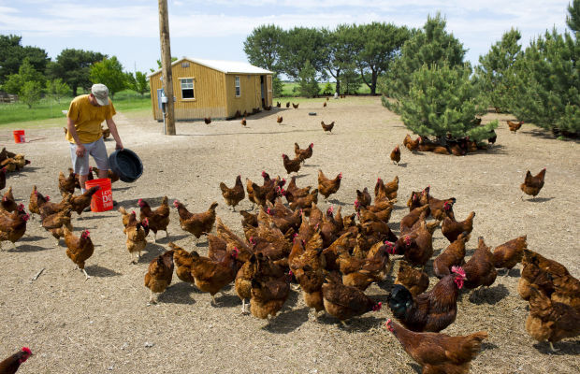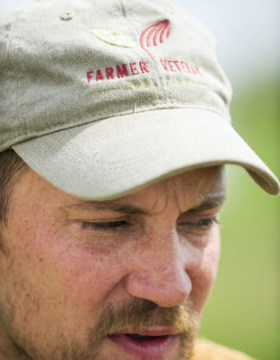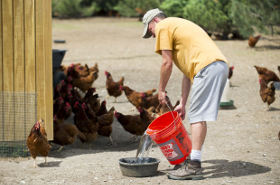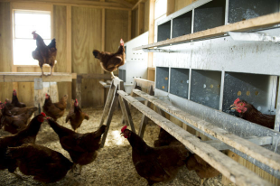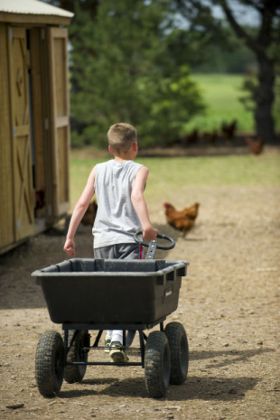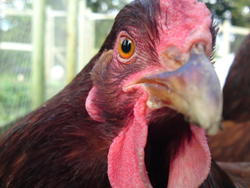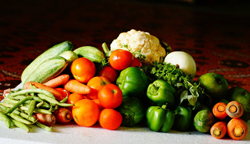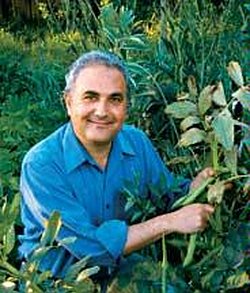 William Rubel (williamrubel.com) gives us the low-down on cooking a heritage turkey to perfection. Living in California, Rubel’s two books are ‘The Magic of Fire’, the book on hearth cooking, and most recently, ‘Bread’, a global history.
William Rubel (williamrubel.com) gives us the low-down on cooking a heritage turkey to perfection. Living in California, Rubel’s two books are ‘The Magic of Fire’, the book on hearth cooking, and most recently, ‘Bread’, a global history.
Whether you roast your heritage turkey in the oven, or spit- or string-roast it in front of a fire, there are some basic facts you ought to know about how to best handle heritage turkeys.
Heritage turkeys are different from the most common turkey of American commerce. It is helpful to know a little about them before cooking them for the first time.
The modern turkey was developed for a large breast — hence its name Broad Breasted White or Broad Breasted Bronze — and it was also selected fast growth on a high protein diet. Broad breasted turkeys reach marketable size after a few months, while heritage turkeys take much longer to reach marketable weight. Broad Breasted birds are often so heavy their own legs can’t property support them, so Broad Breasted birds tend to be sedentary. Variety, age, physical activity, and feed, are all factors that affect the taste and texture of the heritage turkey you buy.
While variety is a factor in the taste and texture of heritage turkeys, as a rule the turkey variety is not on the label. In any case, heritage turkeys are similar enough to make generalizations possible.
Basic qualities of heritage turkeys:
1. Smaller breast. The breast of heritage birds is smaller in proportion to the rest of the bird than is the breast of the Broad Breasted varieties. This means the balance between white and dark meat is more even that it is with commercial turkeys.
Implications for the cook: White meat is “done” before the dark meat is “done,” and so the closer the balance between white and dark meat, the easier it is to roast the entire bird to perfection.
Historically, cookbook authors suggested covering the breast of roasting turkeys with oiled paper until the bird was almost done, at which point the paper was removed. The instruction to put something over the turkey breast is found in Enlish cookbooks dating from the 17th century all the way up through English and American cookbooks to the early 1960’s, at which point the instruction seems to drop out of cookbooks.
If you cover the breast, I recommend sticking with the traditonal oiled paper rather than substituing alluminum foil. Foil doesn’t let any moisture out, and thus steams the breast in a way that paper does not. When you let water molecules escape through a covering of paper, or cloth, the flesh of the bird is chemically changed in a way that is different from what happens through steaming — which is the effect of sealing the breast with alluminium foil. If you want to cover the breast, then cut out a piece of brown paper from a shopping bag, rub it with cooking oil, and tie it in place with cotton string. Remove it about 30 minutes before the turkey is done.
In my own cooking style I do not cover the breast. Instead, I add additional fat to the breast meat by slipping fat, like butter or olive oil, under the skin over the breast. I will discuss a little, below, turkey should not be over-cooked. Cooking to a temperature that is lower than the current custom. If you cook your bird to 140F you will help insure that the meat is not dry. Always start roasting with a bird that is at room temperature.
2. Leaner birds: The fattest part of a mature heritage turkey is the skin that circled the neck.
Implications for the cook: Hot, quick cooking is a better approach to cooking lean birds than is slow cooking unless you add fat to the flesh which can be done by putting butter or olive oil under the skin, or even by larding with salted pork fat.
My advice, however, is to treat the bird more the way you would game birds — pheasant and ducks are both traditionally cooked hot. I roasted my first heritage turkeys — they were small turkeys (6 pounds each) in a bread oven at 630F for 35 minutes. They were perfect. I cooked them to 140F. I suggest roasting in a hot oven — 425F to 450F.
A second suggestion is to put fat under the skin of the turkey. Those of you familiar with my book, The Magic of Fire, know that I often favor slipping a paste of olive oil and pounded garlic and herbs under the skin of poultry. It is easy to slip oil and/or butter under the breast, and a little more difficult to get it over the leg and thigh. Slip your hand under the breast work it around as best you can. Putting fat under the skin makes the turkey self-basting. Because heritage turkeys have a mild flavor, slipping flavor under the skin with oil and butter as a carrier lets you easily produce a bird of memorable flavor.
2. Size: Heritage turkeys are generally smaller than commercial turkey varieties. Expect turkeys in the range of 9 to 15 pounds, although birds that are both smaller than 9 pounds, and larger than 15 pounds are available.
Implications for the cook: Roast the smaller birds hotter than the bigger birds. I would cook a 6-pound bird even as hot as 630F. A 9-pound bird you might cook at 475F — but no less than 450F. I would roast a 15-pound bird at 425F. I have not tested these other sizes in an oven — at home roast birds hanging from a string in front of my fire — so these temperatures are my best guess.
I know that if you ask around enough you are bound to run across people who will tell you the opposite — they will say to roast the birds slowly. What should you do in the face of conflicting advice? Do what you are most comfortable doing. If what you do doesn’t work out well — then do it differntly next time. As long as you keep an eye on what you are cooking you cannot really fail. If you are spit- or string-roasting in front of the fireplace then the timing depends on the heat of your fire. I tend to roast hot. My most recent times are a 10-pound stuffed turkey in about 1 1 /2 hours and a 15-pound unstuffed turkey in roughly 2 hours.
3. Flavor: As a rule, heritage turkeys have a more subtle, cleaner flavor than commercial turkeys. There is often less of what I have come to think of as a “turkey flavor.” Depending on the variety, and the way it was raised, the flavor may offer a hint of the wild side — or offer an almost blank palate for you to work with.
Implications for the cook: Historically, turkeys were served with a sauce, and it was the sauce, plus the meat, that constituted a serving of turkey. A light sauce made from the pan drippings is alway a good idea. Slipping flavors, herbs, garlic, and salt pounded up with olive oil or butter and slipped under the tukey’s skin is also often a good idea.
4. Aging the turkey: Wild turkeys — turkeys that are hunted — are always hung for a few days before being eaten. You can deepen the flavor of your heritage turkey, and make it more tender, by letting it age in your refrigerator. I have done this with small birds to excellent effect. The idea is to take the turkey out of whatever it might have been packaged in, remove any organs packed in the neck or stomach area, rinse it, and then hang the turkey in your refrigerator, uncovered. If you can’t hang it then let it rest on a platter, but turn it once a day so that no part of the turkey is always resting on the platter. Keep the platter dry — so wash off any fluids that might settle in the platter and then dry it before setting the turkey on it. I aged one of my turkeys this year for a week. My own refrigerator is an old one that frosts up. I have not tested aging a turkey in a frost-free refrigerator. Frost-free refrigerators tend to dry out whatever is stored in them, so this is something you would need to experiment with.
Implications for the cook: Smaller turkeys — under ten pounds — can sometimes be purchased for less than larger turkeys because there is less demand for them. In any case, if you are familiar with aging wild birds, like ducks, then age your heritage turkey in the same way because aging definitely adds a dimension to the roast turkey that cannot be added any other way.
5. Brining the turkey: I do not advise brining heritage turkeys. My own brining theory is to apply brine to secondary poultry — birds that have no flavor. Brine introduces water and salt into the flesh of the bird. This dilutes the natures flavors. While it is true that salt is a flavor enhancer, I think brining is a crude way to develop the flavor of a heritage turkey. I will also mention that the standard method by which birds are cooled after having been slaughtered in American slaughterhouses is to dip them in a bath of cold water. The birds may take up as much as 5% water by weight from this soaking. Letting the bird sit, unwrapped in a frost-free refrigerator of a day or two, see “Aging the turkey,” above, might actually improve flavor by removing some of this excess water.
Basic heritage turkey cooking principles
Starting Temperature
Until the last couple decades, it was assumed that meat was always brought to room temperature before roasting. The 1965 edition of the “Joy of Cooking” advises the turkey be room temperature — 70F — before being cooked. I think this is essential advice for all turkeys. If your turkey was frozen, defrost it in the refrigerator. A few hours before you plan to roast the bird, remove it from the refrigerator and let the bird come to room temperature. The deep flesh, not just the outer half-inch (1 cm), needs to be at or near room temperature before you roast it in order to achieve the best results. If the bird is at 34F (1C) in its interior parts when you start roasting it the breast will be dry long before the deep tissues are cooked.
Cooking temperature
Because heritage turkeys tend to have has little fat, I advise cooking them the way one cooks game birds — quickly. Roast in an oven at 425F to 450F. I have actually roasted small turkeys (6 pounds) in a bread oven at 630 degrees for 35 minutes. My most recent times string-roasting turkeys in front of the fireplace are a 10-pound stuffed turkey in about 1 1 /2 hours and a 15-pound unstuffed turkey in roughly 2 hours.
Finish temperature
Stuffing, if any, is cooked before it is put inside the bird. The stuffing, therefore, is only heated inside the bird, not cooked. If you do stuff a bird, for food safety reasons, stuff it just before roasting. While the USDA (United States Department of Agriculture) calls for cooking turkeys until the stuffing is 160F and the bird is 180F in the thigh, these recommended temperatures are so high that you will dry out the turkey. I would roast a heritage turkey to 140F, and no more. As always, let the bird rest for at least ten minutes before carving.
A note on the cooking termperature: The USDA recommendation of 180F in the deepest part of the thigh and 160F in the stuffing is based on the government’s need to provide a general rule that will cover all health and safety eventualities, including the handling of the bird by people who have not observed basic hygenic princples, like washing their hands before handling the food.
As soon as you get your heritage bird home, take it out of its wrapping. If it arrived in the mail, unpack it and immediatly rinse it. Of course, wash your hands before handling the turkey. It is my understanding that the part of the bird that has the most pathogens is the skin. Even with an internal temperature of 140F the skin of the turkey will be above 220F, way over the temperature needed to sterlize the skin. One needs to balance USDA recommendations against what you know about the source of your meat and the way it was handled.
Eating is not risk-free — and I cannot assure you that my recipe is risk free. I can assure you, however, that a heritage turkey cooked to 140F in a fast oven will remain moist and delicious, while cooking the turkey to 180F is problematic in terms of the final culinary results.

